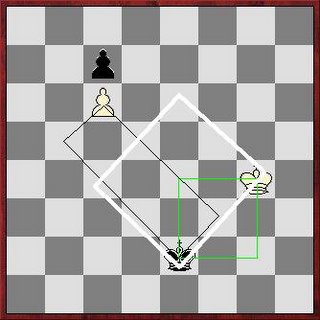Basic pawn endings Blocked pawns 5 - no rook pawns
There exists mainy models to explain sometimes the same observation. We see this in mainy courses for instance chemistry etc. It can also be applied to chess. So I will try to explain Tempo's observation in rather different way.
Diagram

First white to play
1. White King - Black Pawn distance: (g-file (7) - c-file (3)) = 4 moves; 5 fields !
2. Black King - White Pawn distance: 6th rank - 2nd rank = 4 moves
This means if white to play, on the fourth move white will capture the enemy, black pawn. So black has only 3 moves to capture the white pawn or to defend his own pawn. He will not be on time.
Both paths of the king do not interfere!!. No shouldering effect possible.
If Black to play a whole different story.
1. White King - Black Pawn distance: (g-file (7) - c-file (3)) = 4 moves; 5 fields !
2. Black King - White Pawn distance: 6th rank - 2nd rank = 4 moves
For white there are two defenses.
1. direct defense of the pawn (preventing the enemy king to capture the pawn)
2. If your pawn is captured - preventing the enemy pawn to queen!!
White has to make a clear judgement before he embarks in one of the defenses.
in case number one.
After 3 moves of black, white has made 3 moves.
We have the turtle position. The white king is the rabbit king and he will loose the pawn. The black king is standing on the critical square b5 (red square see previous post) and on his 4th move he will be on b6. On white's 4th move he cannot longer defends his own pawn and he has to leave his pawn to the enemy king and with this the game.
Case number two - covering opposition field
General rule: the defending king (white)takes the direct opposition the move following the capturing of his own pawn by black.
So if black needs 4 moves to capture pawn, white will take opposition on his 4th move and not on his 5th move. But it corresponds to the 5 notation on your sheet!!
let us assume that the paths of both kings do not interfere!! (the moves are between brackets)
1...Kd3(1) 2. Kf5(1) Kc4(2) 3. Ke5(2) Kb5(3) 4. Kd4(3) Kxc6(4)5. Kc4 (4)
in our initial position, black has the possibility to interfere !!! because the pathways of both kings cross each other. Both kings have to reach their own destination squares which are c6 for black and c4 for white.
Territory for white to move to reach c4 within 4 moves is covered by the square g4e6c4e2.
Black's territory to capture enemy pawn within four moves is covered by the rectangle e2f3c6b5.

If we draw a square e2e4g2g4, both kings are in the square.This means that both kings are very near and that they can impede each others path depending on the destination square they have to reach.
If you turn the chessboard 45 clockwise, you can easily see why the diagonal!! is the
shortest path for the king.
Within the territory, if you follow the premisses of the shortest path it means that you cannot stay on a file two consecutive moves. As tempo stated this leads to initial prolongment of the path. So no 2 e-moves (= file moves) allowed for the white king. You have to go one step closer to the c-file every turn!!
For black, he has to move through the ranks every turn. He can play e2-e3, coz he respects the territory of the shortest diagonal, and goes every turn to a new rank.
Something for your imagination. The destination squares are black holes. So every move you make has to be in the direction of the destination square within the boundaries of the territory of the shortest diagonal.
so on 1...Ke3!!. whit has 2 choices 2.Kf5 or Kg3.
Kg3 brings your king out of the allowed territory. Black succeeds in prolonging the path for the white king with one tempo. So black wins on this move. Queening cannot be prevented.
Kf5 pushes the white king in the wrong direction (we already saw that the direct defense of the pawn is lost).
So it is a win for black.
Next position will be one with the White king on h8 - introduction of Knight opposition and how to identify the right path.
Diagram

First white to play
1. White King - Black Pawn distance: (g-file (7) - c-file (3)) = 4 moves; 5 fields !
2. Black King - White Pawn distance: 6th rank - 2nd rank = 4 moves
This means if white to play, on the fourth move white will capture the enemy, black pawn. So black has only 3 moves to capture the white pawn or to defend his own pawn. He will not be on time.
Both paths of the king do not interfere!!. No shouldering effect possible.
If Black to play a whole different story.
1. White King - Black Pawn distance: (g-file (7) - c-file (3)) = 4 moves; 5 fields !
2. Black King - White Pawn distance: 6th rank - 2nd rank = 4 moves
For white there are two defenses.
1. direct defense of the pawn (preventing the enemy king to capture the pawn)
2. If your pawn is captured - preventing the enemy pawn to queen!!
White has to make a clear judgement before he embarks in one of the defenses.
in case number one.
After 3 moves of black, white has made 3 moves.
We have the turtle position. The white king is the rabbit king and he will loose the pawn. The black king is standing on the critical square b5 (red square see previous post) and on his 4th move he will be on b6. On white's 4th move he cannot longer defends his own pawn and he has to leave his pawn to the enemy king and with this the game.
Case number two - covering opposition field
General rule: the defending king (white)takes the direct opposition the move following the capturing of his own pawn by black.
So if black needs 4 moves to capture pawn, white will take opposition on his 4th move and not on his 5th move. But it corresponds to the 5 notation on your sheet!!
let us assume that the paths of both kings do not interfere!! (the moves are between brackets)
1...Kd3(1) 2. Kf5(1) Kc4(2) 3. Ke5(2) Kb5(3) 4. Kd4(3) Kxc6(4)5. Kc4 (4)
in our initial position, black has the possibility to interfere !!! because the pathways of both kings cross each other. Both kings have to reach their own destination squares which are c6 for black and c4 for white.
Territory for white to move to reach c4 within 4 moves is covered by the square g4e6c4e2.
Black's territory to capture enemy pawn within four moves is covered by the rectangle e2f3c6b5.

If we draw a square e2e4g2g4, both kings are in the square.This means that both kings are very near and that they can impede each others path depending on the destination square they have to reach.
If you turn the chessboard 45 clockwise, you can easily see why the diagonal!! is the
shortest path for the king.
Within the territory, if you follow the premisses of the shortest path it means that you cannot stay on a file two consecutive moves. As tempo stated this leads to initial prolongment of the path. So no 2 e-moves (= file moves) allowed for the white king. You have to go one step closer to the c-file every turn!!
For black, he has to move through the ranks every turn. He can play e2-e3, coz he respects the territory of the shortest diagonal, and goes every turn to a new rank.
Something for your imagination. The destination squares are black holes. So every move you make has to be in the direction of the destination square within the boundaries of the territory of the shortest diagonal.
so on 1...Ke3!!. whit has 2 choices 2.Kf5 or Kg3.
Kg3 brings your king out of the allowed territory. Black succeeds in prolonging the path for the white king with one tempo. So black wins on this move. Queening cannot be prevented.
Kf5 pushes the white king in the wrong direction (we already saw that the direct defense of the pawn is lost).
So it is a win for black.
Next position will be one with the White king on h8 - introduction of Knight opposition and how to identify the right path.


1 Comments:
I commented on your comment on my post:)
It is inspiring to see a different approach to the same problem. I'm curious to what you find when the pawns are not blocking each other but they have still a few ranks in between. I noticed that in order to win, you have to add the tempo's to save your own pawn to the moves you need to conquer your opponents pawn.
Post a Comment
<< Home